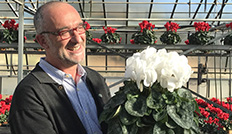 Professional area | Culture factsheet | Light and temperature | Controlling summer temperatures in the glasshouse
Professional area | Culture factsheet | Light and temperature | Controlling summer temperatures in the glasshouse
Temperature control is achieved mainly by whitening the glasshouse (droplet application) and by using shading screens, though if these are improperly handled they can provoke elongation of the cyclamen.
Philippe Morel, head of the pot plant section of the former CNIH research station at Angers, explains in an article in the 1994 P.H.M. Revue Horticole that present-day glasshouses provide excellent insulation from cold in winter, by means of good draught exclusion and use of the “greenhouse effect”. But this greenhouse effect which is an ally in winter is a redoubtable enemy during late spring and summer, when the strong summer sunshine can overheat the glasshouse.
There are a number of remedies for this difficulty; and the choice of procedure will depend on its effectiveness, cost, and gardening practices.
The glazed surfaces of the glasshouse may be whitewashed, by applying white paint, preferably in the form of finely-spattered drops and not as a complete coat. This lessens the quantity of radiation passing into the glasshouse. Spattering provides for a diffraction of the incident rays and a better distribution throughout the glasshouse in the form of a halo. However, this system based on reducing the transparency of the glasshouse is not very flexible in use, and has an adverse effect on growth towards the end of the season or in overcast weather. There has to be provision therefore for partly or progressively removing the whitewash as soon as the days begin to draw in.
Another option is the use of shading screens as necessary in the glasshouse. The cloth used should ideally be an open-textured one: for instance a woven cloth with fairly large interstices which can be fitted with small reflective strips. The heat generated by the radiation which does enter the glasshouse must not be trapped inside; and to avoid this there must be a gap of a few tens of centimetres left between each width of shading screen so that warm air can escape. This makes for a problem: the gap leaves unprotected areas where the plants are directly exposed to full sunlight. Sometimes a double screen is used to get around this, with staggered shading screens; but this is a more costly solution.
Finally, it is possible to keep down the glasshouse temperature by altering the humidity. However, the humidity then hardly ever falls below 70%, and the equipment is fairly costly to install: it is hardly ever used in cyclamen growing.
MOREL P. - Maîtrise des températures estivales sous serre : plaidoyer pour le brouillard. P.H.M. Revue Horticole, n°347, Mars 1994, p. 27-33
2565, rue de Montourey
83600 Fréjus - France
International telephone : +33 (0)4 94 19 73 04
Switchboard : + 33 (0)4 94 19 73 00
Fax : +33 (0)4 94 19 73 19

